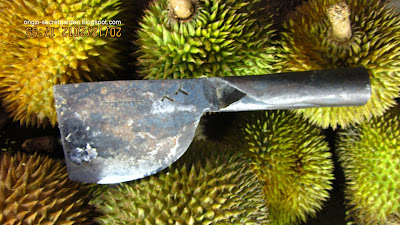January
24, 2013, Thursday Conny Banji
 |
| WAITING TO BE SOLD: Engkabang fruit collected by Punga. |
 |
TRADITIONAL TREASURE:
Punga Manja peels off the skin from the fruit.
|
KANOWIT:
The ‘engkabang’ may not be priced as high as most commodities, but longhouse
folk enjoy collecting the fruit for the fun of it.
An
engkabang tree bears fruit every four to five years.
Forest
Research Institute of Malaysia (FRIM) regards the engkabang fruit (Shorea
macrophylla) as ‘butter from the rainforest’ for its buttery texture when
cooked in bamboo.
Punga
Manja, in her 70s, from Rumah Jarau, Nanga Sibau in Ulu Sungai Ngemah here was
among those who collected the fruit.
“Collecting
the fruit is like a tradition for us longhouse folk in the rural area.
“I
have been collecting the fruit since I was a child. Most of the collection is
for sale, with some for making engkabang oil,” she told The Borneo Post when
met at her longhouse recently.
Engkabang
tree, with a known record of 50 metres tall and four metres in girth, is one of
the lightest wood in the red ‘meranti’ group.
The
trees are mostly found along the rivers.
Punga
sells the dried fruit to a shopkeeper in Nanga Ngemah for 80 sen per kg.
“In
my younger days, the price could fetch up to RM2 per kg.
“Not
many people want to sell the fruit now. They use it to make oil which is high
in demand.
“The
oil cooked in the bamboo and then cut into small sections with each section
measuring about five inches is usually sold for RM5.
 |
| Engkabang fruit. |
“Many
like its rich buttery taste especially when applied on hot rice,” she said,
adding that her granddaughter working in Sibu had frequently asked her for the
oil.
Thirty-six-year-old
Luli Renggan from Rumah Andrew Balun in Nanga Ngungun resettlement scheme here
collects the fruit with her children on weekends.
She
sells the fruit as she does not know how to make oil out of it.
“I
sell the fruit for RM1 per kg in Nanga Ngemah while in Kanowit, the price is
RM1.50 per kg.
“The
fruit is plentiful in Sungai Ngungun, but not many youngsters want to collect
it because of the low price,” she said.
Meanwhile,
Punga has unselfishly shared the method to get engkabang oil.
She
said the skin must be peeled off before the fruit was left to dry in the sun or
smoked.
Dried
fruit is then pounded and squeezed to extract the oil for cooking in the
bamboo.
“When
it is cooked, it will be left to cool in the bamboo. The texture is like butter
when it hardens.
“Besides
cooking, the oil is also used for massage,” she said.
It
is believed that the oil, rich in an anti-aging property, has found its way
into some cosmetic products.

